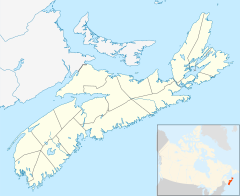Grand Narrows Bridge
| Grand Narrows Bridge | |
|---|---|

Grand Narrows Bridge in 1900
|
|
| Coordinates | 45°57′35.75″N 60°48′1.03″W / 45.9599306°N 60.8002861°WCoordinates: 45°57′35.75″N 60°48′1.03″W / 45.9599306°N 60.8002861°W |
| Carries | 1 rail line (Cape Breton and Central Nova Scotia Railway) |
| Crosses | Bras d'Or Lake at the Barra Strait |
| Locale | Cape Breton Island (Iona, Victoria County, Nova Scotia – Grand Narrows, Cape Breton Regional Municipality) |
| Official name | Grand Narrows Bridge |
| Other name(s) | Barra Strait Railway Bridge |
| Maintained by | Cape Breton and Central Nova Scotia Railway |
| Characteristics | |
| Design | Truss bridge |
| Total length | 516.33 m (1,694 ft) |
| Width | 1 rail line |
| Longest span | 73.76 m (242.0 ft) |
| History | |
| Constructed by | Isbester and Reid |
| Fabrication by | Dominion Bridge Company |
| Construction start | 1887 |
| Construction cost | $530,000 |
| Opened | 18 October 1890 |
The Grand Narrows Bridge is a Canadian railway bridge crossing between Victoria County, Nova Scotia, and Cape Breton County. At 516.33 m (1,694 ft), it is the longest railroad bridge in the province. The bridge incorporates a swing span at its eastern end to permit the continued passage of marine traffic through the strait.
It is an arch truss design, consisting of seven riveted steel trusses, each 73.76 metres (242 ft) long, set on cut stone piers. The Grand Narrows Bridge crosses the Barra Strait of Bras d'Or Lake, carrying the Sydney Subdivision of the Cape Breton and Central Nova Scotia Railway between Iona, Victoria County, on the West side, and Grand Narrows, Cape Breton County (Cape Breton Regional Municipality) on the east side.
In 1887 the firm of Isbester and Reid contracted to build the foundations of a bridge at Grand Narrows, Cape Breton, and a 46-mile stretch of the Intercolonial Railway between the narrows and Point Tupper, near Port Hawksbury.
Work was under way by 1889 when one of the principals of the firm, Robert Gillespie Reid, arrived on site and spent some three weeks testing sea bed sediments and measuring the currents running through the Barra Strait. This was necessary as the strait is deep, over 50 metres (164 ft) deep at its southern end and still over 28 metres (92 ft) deep at the site chosen for the new bridge at the northern limit of the strait between Uniacke Point to the west and Kelly Point to the east. Other complicating factors in the construction of the bridge were the very strong, erratic tidal currents in the strait, overburden on the bedrock, and the presence of ice during the winter and spring breakup.
...
Wikipedia

